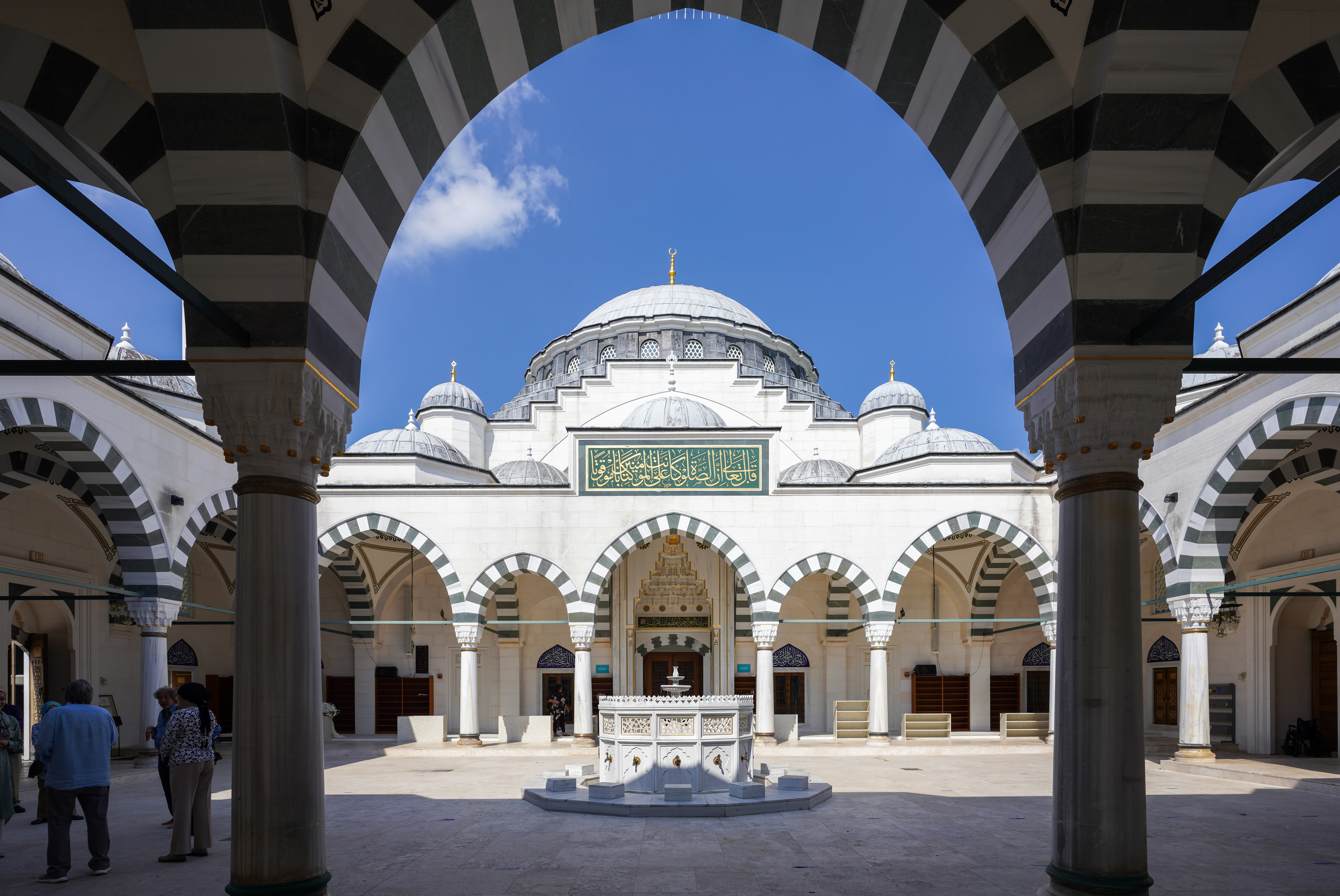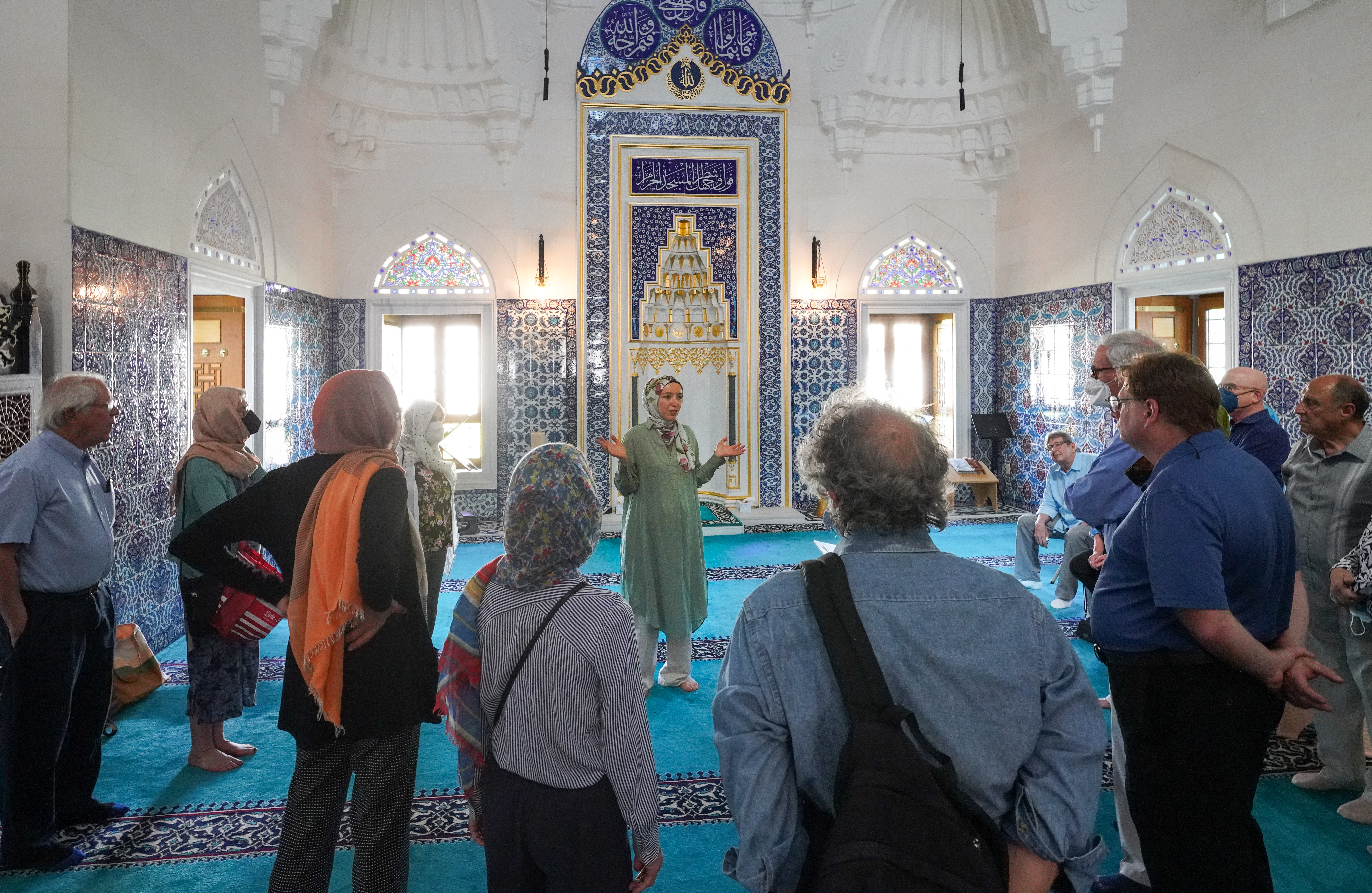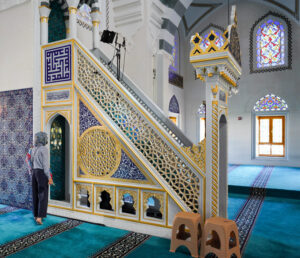
As a companion experience to her course on Muslim Prayer in America, ICJS Muslim Scholar Zeyneb Sayilgan led a tour of the Diyanet Center of America, a mosque in Lanham, Md., for class participants, as well as staff and friends of ICJS.
The tour included a discussion about the architecture led by Zeyneb and one of the mosque’s architects, Ahmet Kilic. Additionally, the group listened to a recitation of the Qur’an by Imam Yakup Kansizolu. The group then observed the late afternoon prayer and closed the evening with food and fellowship at the mosque’s restaurant.
of the mosque’s architects, Ahmet Kilic. Additionally, the group listened to a recitation of the Qur’an by Imam Yakup Kansizolu. The group then observed the late afternoon prayer and closed the evening with food and fellowship at the mosque’s restaurant.
Besides leaving with stomachs full of Turkish tea and baklava, Zeyneb also hoped those who participated would gain:
- An experience of observing Muslim prayer.
- An understanding of the interreligious landscape in the Baltimore area.
- An appreciation for the rich history of Islamic civilization.
Deeper Understanding of Muslim Prayer
“Part of embodied pedagogy is to allow students to feel, to be in the space, to hear the call to prayer,” Zeyneb said. “You can read about Islam in a textbook, but it will only get you so far. It’s just different to sit there on the prayer floor and take it in.”
She explained that experiential learning is especially important for people who want to understand Muslim prayer, because of how physical the ritual is. “Islam is really about the embodied experience—the movements and the sitting on the floor and the bringing your whole, full self to God,” she said.
Many participants reflected on the aesthetics of the mosque, including Sharalyn Luciani, who had participated in the companion course. “The colors inside and the beauty of the outside were overwhelming,” she said.
Interreligious Landscape
The mosque visit raised the issue of the lack of Muslim visibility in the United States. Approximately 300,000 Muslims live in the region between Baltimore and Richmond and Muslims in Maryland worship in approximately 40 local mosques, but many non-Muslims are unaware of how present Islam is in the area.
“Seven or so people said it was their first time ever visiting a mosque,” Zeyneb said, and others had “visited a mosque overseas, but they’re not exposed to the religious landscape in America.”
Why such poor Muslim visibility? “We don’t have very good outreach because we don’t prioritize it as much,” she said. Inviting non-Muslims into the space will help, as visitors recognize the quiet everyday worship that happens in Muslim spaces around them.
“As someone who’s really only studied Islam through the lens of Middle Eastern history, it’s a good reminder that Muslim people live everywhere in the world,” said student Jeremiah Savage.
History of Islamic Civilization
 The mosque, which was built in the Ottoman style, was commissioned by the Turkish government in 1993. It is located on a campus that includes a cultural center, a guest house, a fellowship hall with a restaurant and shops, and a recreational building.
The mosque, which was built in the Ottoman style, was commissioned by the Turkish government in 1993. It is located on a campus that includes a cultural center, a guest house, a fellowship hall with a restaurant and shops, and a recreational building.
William Becker, a world cultures teacher at a detention center in Baltimore County, recognized the inspiration of the mosque’s design. “I’ve seen pictures of similar designs during the Ottoman Empire period and in Istanbul, and I thought it was very interesting to see how they had recreated it here,” he said.
Despite its origins, Zeyneb estimates that around 90% of Muslims who attend the mosque now are not Turkish. Even so, those who worship there latch onto the communal identity that’s rooted in its Turkish heritage.
“I think Islamic civilization’s history symbolizes that Muslims were about building, contributing, constructing,” Zeyneb explains. Learning about Turkey’s role as the Ottoman caliphate can be a tool for educating against bias, bigotry, and Islamophobia. By doing so, she hopes education can “challenge that narrative that Islam is a destructive religion—a religion of terror and all of that.”
Muslims from all over the world find community in the Turkish culture and history. “For Muslims, it’s a sense of pride. Many of them love the mosque because it speaks of what Islam had to offer to different cultures and civilizations,” she said. “Whether it’s art or science, poetry, you name it. This mosque displays that—the beauty and the aesthetics that the tradition stresses so much.”